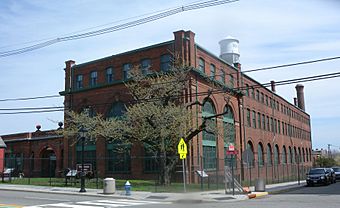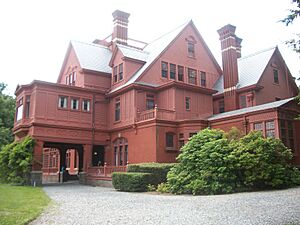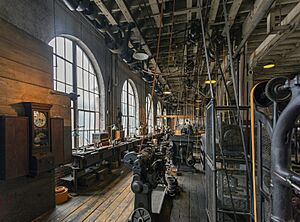Thomas Edison National Historical Park facts for kids
|
Thomas Edison National Historical Park
|
|

Thomas Edison's Laboratory
|
|
| Location | 211 Main Street, West Orange, NJ 07052 |
|---|---|
| Area | 21.25 acres (8.60 ha) |
| Built | 1887 |
| Architect | H. Hudson Holly |
| Architectural style | Late Victorian, Queen Anne |
| Visitation | 55,284 (2011) |
| Website | Thomas Edison National Historical Park |
| NRHP reference No. | 66000052 |
Quick facts for kids Significant dates |
|
| Added to NRHP | October 15, 1966 |
| Designated NHP | September 5, 1962 (as NHS, redesignated NHP March 30, 2009) |
Thomas Edison National Historical Park is a super cool place in West Orange, New Jersey. It protects the amazing laboratory where Thomas Edison invented many things. It also preserves his beautiful home, called Glenmont. These buildings were designed in 1887 by an architect named Henry Hudson Holly.
Edison's laboratories were busy for over 40 years! Many incredible inventions came from here. These included the first motion picture camera and better phonographs for playing music. Sound recordings, silent movies, and even movies with sound were created here. Edison also developed the nickel-iron alkaline electric storage battery. This park lets you step back in time and see where these big ideas came to life!
Contents
Exploring Edison's Amazing Park
The park has two main parts in West Orange. One is the famous Edison Laboratories complex. The other is Edison's home, Glenmont. It's about half a mile (0.8 km) west of the labs.
The Incredible Laboratory Complex
The laboratory complex is like a giant workshop built by Edison in 1887. This is where he researched and developed his many inventions. There are more than a dozen buildings in the complex. They helped Edison explore electricity, photography, and motion pictures. He also studied chemistry, metal work, and many other subjects.
Inside the main lab building, Edison had a private library. There were also special shops for making heavy and super precise machine parts. These shops helped create tools and early versions of his inventions.
One very special building was Edison's Black Maria. This was the world's first movie studio! The building could even spin around on a turntable. This helped keep sunlight on the actors and film subjects. A copy of the Black Maria was built in 1954, so you can still see what it looked like.
Edison's Home: Glenmont
Edison's home, Glenmont, is a beautiful house. It was designed by Henry Hudson Holly and built between 1880 and 1882. It originally had 23 rooms! The house was very modern for its time. It had central heating, indoor toilets, and hot and cold running water.
Edison bought Glenmont in 1886. He moved in with his new wife, Mina, and his three children. The house still has its original furniture, showing the style of that time. Edison later added six more rooms and, of course, electrical wiring!
Edison and Mina's children grew up at Glenmont. Two of them became famous. Charles Edison later became the governor of New Jersey. Theodore Miller Edison became an important industrialist.
A Look Back: The Park's Story
Edison's home became a special historic site on December 6, 1955. The laboratory became another historic site on July 14, 1956. Then, on September 5, 1962, both the home and the lab were combined. This 21-acre (8.5-hectare) area became the Edison National Historic Site.
On March 30, 2009, the site got a new name. It became the Thomas Edison National Historical Park. The word "Thomas" was added to help people know it was different from other Edison sites. After a lot of work to fix up the laboratory complex, it reopened on October 10, 2009.
More Places to Discover
- Edison State Park
- Edison Storage Battery Company Building
- Thomas Alva Edison Memorial Tower and Museum
- National Register of Historic Places listings in Essex County, New Jersey
- List of museums in New Jersey




